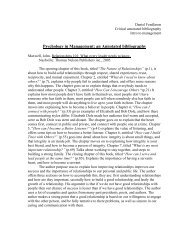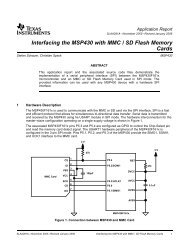Analog Circuit Design Laboratory Report - MyWeb at WIT ...
Analog Circuit Design Laboratory Report - MyWeb at WIT ...
Analog Circuit Design Laboratory Report - MyWeb at WIT ...
Create successful ePaper yourself
Turn your PDF publications into a flip-book with our unique Google optimized e-Paper software.
EVALUATING OPERATIONAL AMPLIFIERS INCLUDING BASIC<br />
CHARACTERISTICS, USE AS VOLTAGE COMPARATORS, CLOSED LOOP AND<br />
DIFFERENTIAL AMPLIFIERS AND IN SIGNAL CONDITIONING DESIGN<br />
1<br />
Whitney Brown<br />
Portia Lane<br />
Adam Ysasi<br />
October 21, 2005
Objectives<br />
• Measure basic op-amp characteristics including ± VSAT, Iload, Isupply, and shortcircuit<br />
current ±ISC<br />
• Simul<strong>at</strong>e op-amp characteristic measurements using PSpice<br />
• Gener<strong>at</strong>e VO versus time graph and transfer function of non-inverting voltage<br />
compar<strong>at</strong>or<br />
• <strong>Design</strong> and test voltage compar<strong>at</strong>or with bipolar voltage reference<br />
• Connect LED’s to voltage compar<strong>at</strong>or output to identify output current direction<br />
• <strong>Design</strong> and analyze inverting and non-inverting amplifiers with neg<strong>at</strong>ive feedback<br />
• Simul<strong>at</strong>e measurements of three op-amp configur<strong>at</strong>ions using PSpice<br />
• Measure closed-loop voltage gain ACL and phase shift θ between input and output<br />
voltages for inverting and non-inverting amplifiers<br />
• Measure and calcul<strong>at</strong>e basic characteristics of differential amplifier including<br />
differential gain ADIFF, common mode gain ACM, and common mode rejection<br />
r<strong>at</strong>io CMRR<br />
• Build and test discrete three-op-amp instrument<strong>at</strong>ion amplifier<br />
• Add offset voltage to reference terminal of instrument<strong>at</strong>ion amplifier<br />
• Test characteristics of AD620 instrument<strong>at</strong>ion amplifier from <strong>Analog</strong> Devices,<br />
Inc.<br />
• Gener<strong>at</strong>e system equ<strong>at</strong>ion for weight measurement system<br />
• Gener<strong>at</strong>e linear performance equ<strong>at</strong>ion for commercial load cell<br />
• Gener<strong>at</strong>e SCC design equ<strong>at</strong>ion to convert load cell output for input into<br />
microcontroller<br />
• Build, test, and calibr<strong>at</strong>e complete weight measurement system<br />
Discussion of Theory<br />
Oper<strong>at</strong>ional amplifiers or op-amps were originally built with discrete transistors and<br />
resistors, and were named after their first uses of m<strong>at</strong>hem<strong>at</strong>ical oper<strong>at</strong>ions (add, subtract,<br />
multiply, divide, integr<strong>at</strong>e, differenti<strong>at</strong>e etc.) Today they are built as integr<strong>at</strong>ed circuits<br />
(IC) and are used for applic<strong>at</strong>ions th<strong>at</strong> encompass the spectrum of electronics from signal<br />
conditioning to signal gener<strong>at</strong>ion. One reason for their high usage in circuit design is the<br />
tendency of op-amp characteristics to act <strong>at</strong> levels quite close to those predicted<br />
theoretically, th<strong>at</strong> is the characteristics of an op-amp perform close to the assumed ideal. 1<br />
1 Smith, Sedra. Microelectronic CIRCUITS. Oxford University Press, New York, 1982. Pg. 63-64.<br />
2
The ideal op-amp generally has 5 terminals, two input terminals (pins 2 and 3),<br />
one output terminal (pin 6), and two power supply terminals (pins 7 and 4), see Figure 1.<br />
Pin 2 is the inverting input terminal while pin 3 is the non-inverting input terminal. The<br />
power supply terminals are typically connected to a positive voltage, VCC= 15V and to a<br />
neg<strong>at</strong>ive voltage, VEE= -15V, pins 7 and 4 respectively. The characteristics of an ideal<br />
op-amp are th<strong>at</strong> it has an infinite open-loop gain (AOL), an infinite bandwidth (Bwl),<br />
infinite input impedance (Rin), zero output impedance (RO) and zero common-mode gain<br />
(ACM).<br />
When oper<strong>at</strong>ing in its simplest form, displayed in Figure 1, with RL equal to 10-<br />
kΩ (typ), the voltage output of the op-amp is equivalent to the positive or neg<strong>at</strong>ive<br />
s<strong>at</strong>ur<strong>at</strong>ion voltage. The s<strong>at</strong>ur<strong>at</strong>ion voltage (Vs<strong>at</strong>) can be calcul<strong>at</strong>ed by:<br />
+ s<strong>at</strong> = CC −1<br />
V V or 1 + = s<strong>at</strong> EE V V Eq. (1)<br />
The supply current (Isupply), <strong>at</strong> pins 7 and 4 is determined by the supply manufacturer’s<br />
specific<strong>at</strong>ion and ranges from a few milliamps for older products to mega-amps for<br />
today’s new technology. Using Kirkoff’s current law Isupply(+) is equal to Isupply(-) plus the<br />
output current of the op-amp read c′-c, see Figure 1.<br />
I +<br />
sup ply = I ply − I<br />
( + ) sup ( ) o<br />
Eq. (2)<br />
3
Figure 1- Basic Op-amp<br />
When a load resistor value is connected to the output terminal of the op-amp, as<br />
displayed in Figure 1, the op-amp can either be “sourcing” or “sinking” current. When<br />
the op-amp is sinking current, this output current is being delivered by the neg<strong>at</strong>ive<br />
power supply (VEE) and the output voltage will be -Vs<strong>at</strong>. The op-amp sinks a load current<br />
when the direction of the current is from c′ to c and RL has a neg<strong>at</strong>ive voltage drop across<br />
it. The op-amp is sourcing current when the supply current is being delivered by the<br />
positive power supply (VCC) and the output voltage will be a +Vs<strong>at</strong>. When the op-amp<br />
sources a load current the direction of the current is from c to c′ and RL has a positive<br />
voltage drop across it. When the load resistor is very small, a few hundred Ω, the op-amp<br />
goes into short-circuit protection. The typical value of short-circuit current, ISC, for the<br />
741 op-amp is 25mA.<br />
One characteristic of an ideal op-amp is th<strong>at</strong> it has an infinite open-loop gain<br />
(AOL). The typical value for a 741 op-amp is AOL equals 200,000 (200k). The single-<br />
4
ended output voltage Vo is equal the product of the open-loop gain and the differential<br />
voltage, Ed, between pins 2 and 3. The differential voltage, Ed, is equal to the positive<br />
input voltage minus the neg<strong>at</strong>ive input voltage and it controls the polarity of the output<br />
VO. When Ed is positive VO is positive, and when Ed is neg<strong>at</strong>ive VO is neg<strong>at</strong>ive.<br />
V = A E<br />
Eq. (3)<br />
O<br />
OL<br />
5<br />
d<br />
Ed = V ( + ) ⊥ −V<br />
( −)<br />
⊥<br />
Eq. (4)<br />
One function of the op-amp is as a voltage compar<strong>at</strong>or, see Figure 2.<br />
When an AC voltage source, Ei, is connected to the positive input, pin 3, the op-amp is<br />
working as a non-inverting voltage compar<strong>at</strong>or. If the neg<strong>at</strong>ive input, pin 2, is connected<br />
directly to ground, the reference voltage Vref is equal to 0V.<br />
Figure 2- Voltage Compar<strong>at</strong>or<br />
As Ei crosses Vref, going from positive to neg<strong>at</strong>ive, the polarity of VO reverses and<br />
VO changes from +Vs<strong>at</strong> to –Vs<strong>at</strong>. When Ei again crosses Vref, neg<strong>at</strong>ive to positive, VO goes<br />
from –Vs<strong>at</strong> to +Vs<strong>at</strong>. When the voltage source is connected to the neg<strong>at</strong>ive input, pin 2,
the op-amp is working as an inverting compar<strong>at</strong>or where when Ei crosses Vref, neg<strong>at</strong>ive to<br />
positive, VO is inverted and goes from +Vs<strong>at</strong> to –Vs<strong>at</strong>. When Ei crosses Vref, positive to<br />
neg<strong>at</strong>ive, VO is inverted and goes from –Vs<strong>at</strong> to +Vs<strong>at</strong>. Voltage compar<strong>at</strong>ors can be used in<br />
many applic<strong>at</strong>ions such as zero-crossing detectors.<br />
Another important function of the op-amp is as a voltage amplifier. There are<br />
three main circuits th<strong>at</strong> define many of the amplific<strong>at</strong>ion uses of the op-amp. They are an<br />
inverting amplifier, non-inverting amplifier, and a voltage follower. All of these circuits<br />
work off of the of the ideal circuit function of an op-amp. 2<br />
As previously discussed, the basic circuit function of the ideal op-amp is to sense<br />
a differential voltage, Ed, between the voltage inputs signals applied to the op-amp’s two<br />
input terminals 3 . These two inputs have the characteristic of infinite resistance ideally,<br />
meaning th<strong>at</strong> there is no current entering their terminals. The voltage output is the<br />
product of the differential voltage multiplied by the open loop gain, AOL, which for an<br />
ideal op-amp is considered to be infinite.<br />
These two main circuit functions of AOL and Ed combine to be known as a<br />
differential-input single-ended-output amplifier. However, the idea of an infinite gain is<br />
not practical and the op-amp will never be used alone for this reason. The op-amp is<br />
combined with additional passive components in a feedback circuit to provide a finite<br />
gain, known as the closed-loop gain, ACL. The finite gain can be manipul<strong>at</strong>ed to<br />
ultim<strong>at</strong>ely produce a variety of applicable functioning circuits, specifically the inverting<br />
amplifier, the non-inverting amplifier and the voltage follower.<br />
2 Ibid Pg. 65<br />
3 Ibid Pg.65<br />
6
Neg<strong>at</strong>ive feedback occurs when the output is returned to the neg<strong>at</strong>ive input. It<br />
can be used to reverse the direction of change. In amplifiers when the output is fed back<br />
to the neg<strong>at</strong>ive input, the inverted distortions cancel out the distortions produced by the<br />
amplifier itself. In an op-amp circuit neg<strong>at</strong>ive feedback exists if a connection is between<br />
the output terminal (pin 6) and the inverting input terminal (pin 2). This connection can<br />
be may be made with anything th<strong>at</strong> supports a DC current including a wire, resistor, or<br />
b<strong>at</strong>tery. Three basic assumptions are used when explaining the effects of neg<strong>at</strong>ive<br />
feedback. First, the bias current for both the inverting and non-inverting inputs is equal<br />
to zero. Second, the differential voltage Ed is approxim<strong>at</strong>ely 0V. Finally, the voltage on<br />
the non-inverting input with respect to ground is equal to the voltage on the inverting<br />
input with respect to ground.<br />
The inverting amplifier produces an output voltage, see Equ<strong>at</strong>ion 5, which is<br />
equal to the input voltage Vin times by the closed-loop gain, ACL, given in Equ<strong>at</strong>ion 5. The<br />
ACL is derived from Equ<strong>at</strong>ion 5 on principals of Ohm’s Law, see Equ<strong>at</strong>ion 6. A voltage<br />
source is connected to the op-amp’s inverting input, (pin 2) and is grounded <strong>at</strong> the non-<br />
inverting input (pin 3), see Figure 3.<br />
V out ACL<br />
∗VDIFF<br />
. Input<br />
1<br />
= Eq. (5)<br />
V = I ∗ R<br />
Eq. (6)<br />
1<br />
7<br />
1
Figure 3- Inverting Amplifier<br />
The closed loop finite gain, ACL, is possible when the input resistance and the<br />
neg<strong>at</strong>ive feedback resistance are connected between the output and the inverting voltage<br />
source. From a virtual ground cre<strong>at</strong>ed by the sensed difference between the op-amp’s<br />
inputs, a node equ<strong>at</strong>ion can be made based on Kirchoff’s Current Law, as st<strong>at</strong>ed below:<br />
All currents entering a node equal the sum of currents leaving a node.<br />
From this equ<strong>at</strong>ion, the feedback resistor, Rf, acquires a current with equal and opposite<br />
value of the current across the input resistor, Rin, driven by the input source. Only these<br />
two currents are involved in the node equ<strong>at</strong>ion because the inverting input pin takes no<br />
current due to its ideally infinite resistance. The current across Rin and Rf must then be<br />
equal. Because of the virtual ground VO is equal to the voltage drop across Rf. Therefore<br />
the ACL can be written as shown in Equ<strong>at</strong>ion 7. The gain is a result of neg<strong>at</strong>ive feedback.<br />
A<br />
− R<br />
= Eq. (7)<br />
f<br />
CL Rin<br />
8
The non-inverting amplifier works similarly to the inverting amplifier. The non-<br />
inverting amplifier has a different neg<strong>at</strong>ive feedback loop by removing the source <strong>at</strong> the<br />
inverting pin. Thus changes the direction of the current across Rf, see Figure 4.<br />
Figure 4- Non-inverting Amplifier<br />
The inverting pin, now grounded, allows for Rin current and Rin voltage to be determined<br />
since a virtual ground is cre<strong>at</strong>ed with respect to Vin and an Ed of zero. This is also due to<br />
the inverting pin taking on no current due to its infinite resistance. The Rf current can<br />
then be found from Kirchoff’s Current Law because it is the only other current involved<br />
with the known current <strong>at</strong> Rin meeting <strong>at</strong> the virtual ground node. The direction of current<br />
flow there shows RF supplying the current to Rin. The gain equ<strong>at</strong>ion for the non-inverting<br />
9
amplifier is given in Equ<strong>at</strong>ion 8 and is now based on the non-inverting amplifier neg<strong>at</strong>ive<br />
feedback loop.<br />
R f A = + 1<br />
Eq. (8)<br />
CL Rin<br />
The voltage follower circuit is an exploit<strong>at</strong>ion of the inverting and non-inverting<br />
amplifiers’ characteristics. It specifically dwells on the non-inverting amplifier’s ability<br />
to source a voltage with infinite resistance and the idea of neg<strong>at</strong>ive feedback to the<br />
inverting input. The voltage follower, also known as a buffer or isol<strong>at</strong>ion amplifier, is<br />
shown in Figure 5.<br />
Figure 5- Voltage Follower Amplifier<br />
The buffer amplifier is capable of delivering a voltage, with out loss or gain, to a<br />
previously non-excepting load. The buffer must be present to condition the high<br />
impedance voltage source for the load.<br />
10
In associ<strong>at</strong>ion with the non-inverting amplifier characteristics, VO is equal to the<br />
Vin since Ed is equal to zero. This configur<strong>at</strong>ion further allows VO to equal Vin since the<br />
inverting pin source, the Rin and the Rf are not present, allowing non-inverting neg<strong>at</strong>ive<br />
feedback and an ACL equal to 1.<br />
Another op-amp configur<strong>at</strong>ion is the differential amplifier as shown in Figure 6.<br />
In this configur<strong>at</strong>ion the common mode voltage ECM is rejected by the op-amp.<br />
Figure 6– Differential Amplifier<br />
The differential gain, ADIFF, is equal to r<strong>at</strong>io of the resistances R and mR as shown in<br />
equ<strong>at</strong>ion 9, and the output voltage is equal to this gain times the input differential voltage<br />
as given in equ<strong>at</strong>ion 10.<br />
ADIFF = mR / R Eq. (9)<br />
VO = ADIFF * (E1 – E2) Eq. (10)<br />
11
One characteristic of differential amplifiers is the common mode gain ACM. Ideally, the<br />
output voltage should be zero when E1 and E2 are connected to the same terminal, so ACM<br />
should also be zero. This value is a measure of the op-amp quality and is equal to the<br />
common mode output voltage VOCM divided by the common mode voltage ECM as given<br />
in equ<strong>at</strong>ion 11.<br />
ACM = VOCM / ECM Eq. (11)<br />
Determining the common mode voltage gain is necessary to calcul<strong>at</strong>e the common mode<br />
rejection r<strong>at</strong>io CMRR. CMRR is the differential voltage gain ADIFF divided by the<br />
common mode voltage gain ACM as given in equ<strong>at</strong>ion 12 and ideally should be infinite.<br />
Because the value is so large the CMRR is generally given in decibels (dB). CMRR can<br />
be converted to CMRR(dB) using equ<strong>at</strong>ion 13.<br />
CMRR = ADIFF / ACM Eq. (12)<br />
CMRR(dB) = 20 log CMRR Eq. (13)<br />
An amplifier similar to the differential amplifier is the instrument<strong>at</strong>ion amplifier<br />
shown in Figure 7. The pin configur<strong>at</strong>ion for this amplifier is like th<strong>at</strong> of am op-amp<br />
except th<strong>at</strong> the differential voltage gain, ADIFF, is determined by the r<strong>at</strong>io of the resistance<br />
Rg connected between pins 1 and 8 and the internal resistance. Also a reference voltage<br />
can be connected through pin 5.<br />
12
Figure 7– Instrument<strong>at</strong>ion Amplifier<br />
The r<strong>at</strong>io of the resistances, referred to as “a,” is given in Equ<strong>at</strong>ion 14. This value is then<br />
used the calcul<strong>at</strong>e ADIFF using Equ<strong>at</strong>ion 15.<br />
a = aR / R = Rg / R Eq. (14)<br />
ADIFF = 1 + 2 / a Eq. (15)<br />
Output voltage VO for the instrument<strong>at</strong>ion amplifier, given in Equ<strong>at</strong>ion 16, is equal to the<br />
differential voltage gain ADIFF times the voltage difference across the input terminals plus<br />
the reference voltage.<br />
VO = ADIFF *(E1 – E2) + Vref Eq. (16)<br />
The op-amp with its many configur<strong>at</strong>ions can be combined and used in several<br />
applic<strong>at</strong>ions of signal conditioning circuit design. Some applic<strong>at</strong>ions th<strong>at</strong> use a<br />
combin<strong>at</strong>ion of op-amp functions are a microprocessor-based d<strong>at</strong>a acquisition system,<br />
13
which converts pressure into a single ended voltage, a semiconductor diode based sensor<br />
system to measure an input temp and output a voltage, and a human engineered weight<br />
measurement system th<strong>at</strong> accepts an input weight and outputs a single-ended voltage.<br />
The system design process incorpor<strong>at</strong>es first describing m<strong>at</strong>hem<strong>at</strong>ically, from the<br />
st<strong>at</strong>ement of the problem, the system to be designed in the standard form 4 :<br />
y = mx + b<br />
Eq. (17)<br />
The linear performance equ<strong>at</strong>ion of the property being measured is calcul<strong>at</strong>ed using d<strong>at</strong>a<br />
measured from the device and put into the standard form of Equ<strong>at</strong>ion 17. The signal<br />
condition circuit equ<strong>at</strong>ion is then determined by the desired output verse the input<br />
calcul<strong>at</strong>ed from the performance equ<strong>at</strong>ion of the device, and put in the standard form of<br />
Equ<strong>at</strong>ion 17. Its characteristics and wide range of functions make the op-amp one of the<br />
fundamental building blocks of circuit design.<br />
Measuring ± VSAT:<br />
Using the LM741 op-amp, whose package can be seen in Figure 1, a configur<strong>at</strong>ion is<br />
wired with two DC power supplies and no output load. One supply power source of<br />
+15V was connected to pin 7 and the second supply power source of -15V was connected<br />
to pin 4. The total potential across these power supplies was measured <strong>at</strong> 30V. Pin 3, also<br />
known as the non-inverting input, was wired to the positive power supply of +15V.<br />
The ±Vs<strong>at</strong> was expected to measure ± 14V; see Equ<strong>at</strong>ion 1. The + Vs<strong>at</strong> was<br />
measured <strong>at</strong> +14.3V and – Vs<strong>at</strong> was measured <strong>at</strong> -13.63V. This measured loss compares<br />
4 Villanucci, Robert. Wentworth Institute of Technology, Electromechanical Engineering. <strong>Labor<strong>at</strong>ory</strong><br />
Exercise Five Handouts.<br />
14
favorably both voltages being within 10% of expected; where the positive supply had a<br />
percent difference of 2.14% and the neg<strong>at</strong>ive supply had a percent difference of 2.64%.<br />
Input pins 2 and 3, were shorted by connecting them both to ground. From the<br />
d<strong>at</strong>a sheet of the op-amp, the AOL is 200, 000 typically. This was then used to calcul<strong>at</strong>e<br />
the Vout based on Equ<strong>at</strong>ion 3, where Ed is equal to the voltage differential across the<br />
inputs. Here, since the inputs have been shorted, Ed is equal to 0V. However, when VOUT<br />
was measured a reading of 14.3V.<br />
This exercise was simul<strong>at</strong>ed in PSpice. This was devised with simul<strong>at</strong>ed<br />
components and adjacent voltage supplies connected by assigning the same name of the<br />
source <strong>at</strong> the inputs.<br />
Figure 8- Positive Vs<strong>at</strong><br />
15
Figure 9- Neg<strong>at</strong>ive Vs<strong>at</strong><br />
Positive Vs<strong>at</strong> was obtained almost m<strong>at</strong>ching the measured values from the<br />
experiment, seen in Figure 8. Neg<strong>at</strong>ive Vs<strong>at</strong> was similarly taken from PSpice with an<br />
acceptable value, see Figure 9.<br />
Measuring Both Load and Supply Current:<br />
The second circuit configur<strong>at</strong>ion was wired as shown in Figure 1 with no load resistance.<br />
The supply currents are from the two separ<strong>at</strong>e power sources. Isupply(+) was measured <strong>at</strong><br />
0.66mA and Isupply(-) was measured <strong>at</strong> 0.662mA. These values were well within the d<strong>at</strong>a<br />
sheet typical Isupply value of 1.7mA. The difference in ± Isupply is acceptable because the<br />
op-amp is still within manufacturer’s specific<strong>at</strong>ions and the op-amp running <strong>at</strong> this lower<br />
current will run cooler than it would if equal to the specific<strong>at</strong>ions.<br />
16
The next configur<strong>at</strong>ion, with a 10-kΩ load resistor connected to pin 6, illustr<strong>at</strong>es<br />
sourcing current. Sourcing current used the positive supply to feed the output and an<br />
additional source is connected to the non-inverting pin 3. Isupply(+) is equal to the sum of<br />
the neg<strong>at</strong>ive supply current and the current; see Equ<strong>at</strong>ion 2. This s<strong>at</strong>isfied Kirchoff’s<br />
Current Law.<br />
Isupply(+) enters into the op-amp, and I supply(-) and the load current, IL, exit the op-<br />
amp. The circuit was broken so th<strong>at</strong> current measurements could be taken for Isupply(-), Iout<br />
and Isupply(+). The sum of Isupply(-) equal to 0.6mA and IL equal to 1.44mA was within 1.4%<br />
of the direct measurement of Isupply(+) equal to 2.13mA. The polarity of the source current<br />
proved th<strong>at</strong> the op-amp was sourcing current to the load as it was positive and equal to<br />
+Vs<strong>at</strong>.<br />
Next, the circuit was configured to sink current. With the 5V source <strong>at</strong> the<br />
connected to the inverting pin 2, the output became -Vs<strong>at</strong>, since voltage follows from<br />
higher to lower potential, the load current is drawn into the op-amp. The op-amp was<br />
then sinking an IL equal to 1.37mA and using the measured value Isupply(+) <strong>at</strong> 0.6mA from<br />
this circuit, to calcul<strong>at</strong>e an Isupply(-) equal to 2.31mA from Equ<strong>at</strong>ion 2.<br />
Based on the sum of Isupply(+) and Iout when compared to the direct current reading<br />
of Isupply(-) provided a percent difference of 12.26%, which is not within the excepted<br />
10%. Sinking current to the load did provide a –Vs<strong>at</strong>.<br />
This exercise was also simul<strong>at</strong>ed on PSpice, see Figure 10. This was devised with<br />
simul<strong>at</strong>ed components and adjacent voltage supplies connected by assigning the same<br />
name of the source <strong>at</strong> the inputs. The results of PSpice were close to those measured in<br />
17
the lab and clearly demonstr<strong>at</strong>e the principal of Equ<strong>at</strong>ion 2; values are noted on Figure<br />
10.<br />
Short-<strong>Circuit</strong> Current Measurements:<br />
Figure 10- Iload and Isupply<br />
The d<strong>at</strong>a sheet gave a typical value for short circuit current of ± 25mA. The circuit was<br />
wired to source current to the load of very small resistance. The small resistance triggers<br />
the short circuit protection so th<strong>at</strong> the op-amp is not damaged. Positive Isc was achieved <strong>at</strong><br />
an acceptable value of 29mA. When configured for sinking current a neg<strong>at</strong>ive Isc acted<br />
across the load and was measured <strong>at</strong> an acceptable value of -23.9mA.<br />
This was also done in a PSpice simul<strong>at</strong>ion, see Figure 11. This was devised with<br />
simul<strong>at</strong>ed components and adjacent voltage supplies connected by assigning the same<br />
name of the source <strong>at</strong> the inputs.<br />
18
Figure 11- Positive Isc <strong>at</strong> approxim<strong>at</strong>ely maximum<br />
PSpice used the maximum d<strong>at</strong>a sheet characteristics for short circuit current, where<br />
Isc(MAX) was approxim<strong>at</strong>ely 40mA for temper<strong>at</strong>ures above room temper<strong>at</strong>ure. Here it also<br />
demonstr<strong>at</strong>ed the principal th<strong>at</strong> Vo can be brought down lower th<strong>at</strong> s<strong>at</strong>ur<strong>at</strong>ed voltage<br />
when load resistance is very low and Isc protection is turned on.<br />
VO vs. Time and VO vs. Ei for Non-inverting Zero-Crossing Detector:<br />
Using the 741 op-amp, the circuit is setup as shown in Figure 12. VCC of 15V and VEE of<br />
-15V are applied to the op-amp prior the applying the voltage Ei. Ei is then set to a ± 10V<br />
(peak) triangle wave <strong>at</strong> a frequency of 50 Hz on the waveform gener<strong>at</strong>or.<br />
19
Figure 12 – Non-inverting zero-crossing detector<br />
Channel 1 of the oscilloscope is used to read Ei and channel 2 to read VO. The<br />
oscilloscope is set to dc coupling mode. Figure 13 displays the plot of VO versus time.<br />
+Vs<strong>at</strong> measures 13.13V and –Vs<strong>at</strong> measures -13.44V. Since the neg<strong>at</strong>ive input (pin 2) is<br />
connected directly to ground, the reference voltage Vref is equal to 0V. As Ei crosses Vref,<br />
going from positive to neg<strong>at</strong>ive, the polarity of VO reverses and VO changes from +Vs<strong>at</strong> to<br />
–Vs<strong>at</strong>. When Ei again crosses Vref, neg<strong>at</strong>ive to positive, VO goes from –Vs<strong>at</strong> to +Vs<strong>at</strong>.<br />
20
Figure 13– Plot of Ei versus time and VO versus time<br />
After grounding both oscilloscope channels and zeroing the electron beam to the center<br />
of the scope face, the oscilloscope is set to display the transfer function for the voltage<br />
compar<strong>at</strong>or as shown in Figure 14.<br />
Figure 14– Plot of VO versus Ei<br />
21
+Vs<strong>at</strong> measures 14.06 V and –Vs<strong>at</strong> measures -12.66 V. These values differ slightly than<br />
recorded previously because of the channels being grounded. This transfer function is<br />
indic<strong>at</strong>ive of a non-inverting compar<strong>at</strong>or. The polarity of Ei and VO are always equal.<br />
<strong>Design</strong> and Testing of a Voltage Compar<strong>at</strong>or:<br />
Figure 15 is the transfer function for an inverting voltage compar<strong>at</strong>or. From this plot<br />
+Vs<strong>at</strong>, -Vs<strong>at</strong>, VCC, VEE, + Ei (peak), - Ei (peak), and Vref can all be determined. +Vs<strong>at</strong><br />
equals 12.5V. –Vs<strong>at</strong> equals -12.5V. Because Vs<strong>at</strong> is approxim<strong>at</strong>ely 1V less than the<br />
power supply voltage, VCC is 13.5V and VEE is -13.5V. +Ei is 7.5V and -Ei is -7.5V.<br />
Because the output polarity changes <strong>at</strong> 0V, Vref is 0V.<br />
Figure 15 – Transfer Function<br />
22
Using the inform<strong>at</strong>ion derived from Figure 5, an inverting voltage compar<strong>at</strong>or is designed<br />
as shown in Figure 16. After applying dc power, Ei is adjusted to a ±7.5 V, 50Hz triangle<br />
wave.<br />
Figure 16 – Inverting voltage compar<strong>at</strong>or<br />
Using the oscilloscope, channel 1 is set to measure the input voltage <strong>at</strong> pin 2. Channel 2<br />
measures the voltage across the load resistance RL. Figure 17 displays these voltages<br />
versus time. +Vs<strong>at</strong> measures +12.50V and –Vs<strong>at</strong> measures -11.44V.<br />
23
Figure 17 - Plot of Ei versus time and VO versus time<br />
In Figure 7, VO and Ei cross p<strong>at</strong>hs <strong>at</strong> a value of 0V. Therefore Vref has a value of 0V. As<br />
Ei crosses Vref and goes above it, the VO polarity reverses and it switches from +Vs<strong>at</strong> to –<br />
Vs<strong>at</strong>. The opposite occurs when Ei again crosses Vref going below it. The polarity again<br />
reverses, changing from –Vs<strong>at</strong> to +Vs<strong>at</strong>. By changing the oscilloscope’s time base to XY,<br />
the plot of VO versus Ei is cre<strong>at</strong>ed as shown in Figure 18.<br />
Figure 18 - Plot of VO versus Ei<br />
24
The output voltage can be altered so th<strong>at</strong> it is not always ±Vs<strong>at</strong>. VO can be reduced to<br />
approxim<strong>at</strong>ely 5V by reducing the load resistance RL. If the load resistance is low<br />
enough the op-amp will enter a st<strong>at</strong>e of short circuit protected in which the current ISC is<br />
typically ±25mA. If the 10-kΩ load resistor is replaced by a 220-Ω resistor, VO equals<br />
3.75V as shown on Figure 19.<br />
Figure 19 - Plot of Ei versus time and VO versus time<br />
Adding LEDs to the output Terminal of an Op-amp:<br />
The compar<strong>at</strong>or test circuit is wired as shown in Figure 20. R2 is a potentiometer with a<br />
range of 0 to 10-kΩ . R2 is adjusted so th<strong>at</strong> the green LED is in the “on” position and the<br />
red LED is in the “off” position.<br />
25
Figure 20 – Test <strong>Circuit</strong><br />
VO, VLED(F) (green), and VLED(R) (red) are measured using the DMM. All three voltages<br />
are equal and measure 2.08V. The output current IO of the op-amp is measured to be<br />
16.8mA. This current indic<strong>at</strong>es th<strong>at</strong> the op-amp is in short-circuit protection. The<br />
direction of the current indic<strong>at</strong>es th<strong>at</strong> the op-amp is sourcing current in this configur<strong>at</strong>ion.<br />
The maximum reverse voltage th<strong>at</strong> can occur across the LED before damage occurs is<br />
5V. The “off” LED is protected since the voltage across it was only 2.08V. R2 is then<br />
adjusted until the red LED is in the “on” position and the green LED in the “off” position.<br />
VO, VLED(F) (green), and VLED(R) (red) equal -1.625V. IO equals -14.8mA. The circuit is<br />
again in short-circuit protection. The recommended forward current across the “on” LED<br />
is from 10mA to 25mA. The measured current is therefore acceptable. Damage is not<br />
likely to occur to the LED because current is limited by the op-amp short circuit<br />
protection current.<br />
26
Analysis of an Inverting Amplifier and Measuring its ACL and Phase Shift:<br />
First, construction of the circuit seen in Figure 3 was done using color coded resistor<br />
values of 33-kΩ for Ri and 100-kΩ for Rf. The resistance of Ri was measured to be<br />
32.7-kΩ and Rf was measured to be 99.27-kΩ . A load resistor was added, and proved to<br />
have no effect on the output voltage. The circuit was wired to an input voltage of ±2V <strong>at</strong><br />
100Hz from the function gener<strong>at</strong>or and source voltages of VCC= +15V and VEE= -15V.<br />
The closed loop gain for the inverting amplifier could then be calcul<strong>at</strong>ed based on its gain<br />
equ<strong>at</strong>ion, see Equ<strong>at</strong>ion 7. The ACL was calcul<strong>at</strong>ed to be -3.036.<br />
An oscilloscope was used with channel 1 monitoring the input voltage and<br />
channel two monitoring the output voltage. A picture was taken of the results, see Figure<br />
19. The graph illustr<strong>at</strong>es th<strong>at</strong> when Vi goes positive, VOUT is neg<strong>at</strong>ive, or vise versa. VOUT<br />
is equal to ± Vs<strong>at</strong>, with its polarity dependant on the polarity of Vi.<br />
Figure 19- Oscilloscope picture of inverting amplifier<br />
27
The experiment was then conducted with the input voltage changed from a peak voltage<br />
of 2V to 5V. This change in voltage caused VOUT to be distorted, note the fl<strong>at</strong> toped<br />
wave, see Figure 20. The distortion was due to the voltage being over amplified; being<br />
th<strong>at</strong> the supplied Vi was too high and was producing an output voltage above Vs<strong>at</strong>. Vs<strong>at</strong> is<br />
the maximum output voltage possible from the source voltages of +15V and -15V, the<br />
supply voltage for op-amps. This means th<strong>at</strong> the circuit designer does have limit<strong>at</strong>ions<br />
and its chosen available ±Vs<strong>at</strong> must be considered.<br />
Figure 20- Distortion of output voltage inverting amplifier<br />
Graphical represent<strong>at</strong>ion of the inverting amplifier was achieved through PSpice<br />
simul<strong>at</strong>ion, see Figure 22. The simul<strong>at</strong>ion consisted of virtual components and virtual<br />
voltage sources connected through virtual wire and part name, see Figure 21. The input<br />
voltage was modeled by a sin wave with amplitude equal to an absolute value of Vi. The<br />
output voltage can be seen with an amplified voltage of an absolute value of 5.97V and a<br />
28
180º phase shift from the Vin. The output voltage was within 2% of the calcul<strong>at</strong>ed value<br />
of an absolute value of 6.07V and the phase shift was measured <strong>at</strong> the expected value of<br />
180˚. Based on the measured input and output voltages, the A CL was calcul<strong>at</strong>ed using<br />
Equ<strong>at</strong>ion 7. The measured ACL value was -2.97. This was within 2.16% of our expected<br />
ACL of -3.03.<br />
Figure 21- Analysis of inverting amplifier circuit<br />
29
Voltage (mV)<br />
8<br />
6<br />
4<br />
2<br />
0<br />
-2<br />
-4<br />
-6<br />
-8<br />
Figure 22- Graphical analysis of inverting amplifier<br />
Analysis of a Non-inverting Amplifier and Measuring its ACL and Phase Shift:<br />
First, construction of the circuit seen in Figure 4 was done using color coded resistor<br />
values of 15-kΩ for Ri and 120-kΩ for Rf. The resistance of Ri was measured to be<br />
14.8-kΩ and Rf measured to be 117 -kΩ. A load resister was placed <strong>at</strong> the terminal of the<br />
output voltage, which proved to have no effect on the value of the output voltage. The<br />
circuit was hooked to an input voltage of ±1V <strong>at</strong> 100Hz from the function gener<strong>at</strong>or, and<br />
source voltages of VCC= +15V and VEE= -15V. The closed loop gain for the non-<br />
inverting amplifier was then calcul<strong>at</strong>ed using the gain equ<strong>at</strong>ion, Equ<strong>at</strong>ion 8. The gain for<br />
the non-inverting amplifier was calcul<strong>at</strong>ed to 8.905.<br />
The experiment was conducted with the input voltage changed from a peak<br />
voltage of 2V to 5V. This voltage change caused distortion of the Vout wave as previously<br />
seen with the Inverting Amplifier.<br />
Inverting Amplifier Analysis<br />
Voltage Output<br />
30<br />
Voltage Input
The oscilloscope had the input voltage monitored by channel one and seen<br />
modeled by a sin wave with an amplitude equal to Vin. The output voltage was monitored<br />
by channel 2. Pictures were taken of the results, see Figure 23 and Figure 24.<br />
Figure 23- oscilloscope picture of non-inverting amplifier<br />
Figure 24-Distorted voltage output oscilloscope picture<br />
31
Graphical represent<strong>at</strong>ion of the non-inverting amplifier was achieved through<br />
PSpice simul<strong>at</strong>ion as seen with the inverting amplifiers. A phase shift of zero was noted<br />
and expected. Vout had a peak voltage of an absolute value of 7.94V. This did not<br />
compare favorably and was calcul<strong>at</strong>ed to be within 10.8% of our expected peak output<br />
voltage of 8.905V. PSpice was repe<strong>at</strong>ed for the distortion of the output voltage, see<br />
Figure 25. The graphical represent<strong>at</strong>ion of the distorted non-inverting amplifier output<br />
can be seen in Figure 26 with the same specific<strong>at</strong>ions as the non-distorted non-inverting<br />
amplifier except having too high of an output voltage value.<br />
Figure 25- Analysis of non-inverting amplifier circuit<br />
32
Voltage (V)<br />
8<br />
6<br />
4<br />
2<br />
0<br />
-2<br />
-4<br />
-6<br />
-8<br />
Figure 26- Graphical analysis of distorted output of non-inverting amplifier<br />
Based on the measured input and output voltages, the ACL was calcul<strong>at</strong>ed from Equ<strong>at</strong>ion<br />
8 for a measured ACL value was 7.94, comparing within 10.8% of our expected ACL,<br />
which is an unacceptable percent error of 10%.<br />
Voltage Follower <strong>Circuit</strong> and Measuring its ACL and Phase Shift:<br />
The voltage follower circuit was wired as shown in Figure 5. The Vin was set to ±5V <strong>at</strong><br />
100Hz by the function gener<strong>at</strong>or. An ACL of 1 was expected because the voltage output is<br />
equal to the input voltage for the voltage follower circuit. The ACL was measured <strong>at</strong> 1.007<br />
comparing favorably to the expected value.<br />
Distorted Vout of Non-inverting Amplifier<br />
The oscilloscope monitored the input voltage on channel 1 and the output voltage<br />
on channel 2. A picture was taken of the results, see Figure 27.<br />
33<br />
Voltage Output<br />
Input Voltage
Figure 27 - Voltage follower oscilloscope picture, adjusted to separ<strong>at</strong>e graphs<br />
A PSpice simul<strong>at</strong>ion was conducted to test the results. The configur<strong>at</strong>ion can be<br />
seen in Figure 28, and a graphical represent<strong>at</strong>ion of the voltage follower can be seen in<br />
Figure 29. The graph emphasizes the overlapping voltage waves by having a display th<strong>at</strong><br />
appears as one wave form but is actually the waveform of the input voltage and the<br />
waveform of the output voltage overlapping it.<br />
34
Voltage (V)<br />
6<br />
4<br />
2<br />
0<br />
-2<br />
-4<br />
-6<br />
Figure 28- Analysis of a voltage follower circuit<br />
Voltage Follower Analysis<br />
Figure 29- Graphical analysis of voltage follower<br />
35<br />
Output Voltage<br />
Input Voltage
Differential Voltage Gain:<br />
The circuit was setup as shown in Figure 30 and E1 and E2 were measured with respect to<br />
ground using the DMM. E1 measured 458mV and E2 measured 448mV. The differential<br />
voltage across the 10-Ω resistor (E1-E2) was calcul<strong>at</strong>ed to be 10mV. The common mode<br />
voltage ECM for this circuit was equal to E2, or 448mV.<br />
Figure 30 – Test circuit to measure ADIFF<br />
With resistors mR and R equal to 100-kΩ and 20-kΩ respectively, the differential voltage<br />
gain, ADIFF, was calcul<strong>at</strong>ed using Equ<strong>at</strong>ion 9. Using Equ<strong>at</strong>ion 10, expected output<br />
voltage VO was calcul<strong>at</strong>ed to be 50 mV. Using the DMM VO was measured as 48.39mV.<br />
The percent error between the calcul<strong>at</strong>ed and measured values was 3.6%.<br />
The differential voltage gain can be altered by simply changing the values of the<br />
resistors. To increase ADIFF to 100, resistor mR could be increased to 2-MΩ, or resistor R<br />
36
could be reduced to 1-kΩ. To decrease ADIFF to 1, resistor mR could be decreased to 20-<br />
kΩ, or resistor R could be increased to 100-kΩ.<br />
Measuring Both ACM and CMRR:<br />
The circuit shown in Figure 30 was modified to include a common-mode adjustment as<br />
shown in Figure 31. The positive and neg<strong>at</strong>ive inputs were both connected to E2. E2 was<br />
then the common-mode voltage, ECM. ECM was then measured as 449.7mV.<br />
Figure 31– Test circuit to measure ACM and CMRR<br />
The DMM was connected to the output of the differential amplifier and the 50-kΩ<br />
potentiometer was adjusted until the smallest output voltage was displayed. This output<br />
voltage was recorded as the VOCM and equal to 0.01mV. The common mode voltage gain<br />
37
ACM was then calcul<strong>at</strong>ed using Equ<strong>at</strong>ion 11. ACM equaled 2.23 x10 -5 . The common<br />
mode rejection r<strong>at</strong>io CMRR was then calcul<strong>at</strong>ed using Equ<strong>at</strong>ion 12, and determined to be<br />
225,529. The circuit shown in Figure 31 could be altered to increase and improve the<br />
CMRR by increasing ADIFF as previously discussed.<br />
AD620 Instrument<strong>at</strong>ion Amplifier:<br />
The circuit was setup with the AD620 instrument<strong>at</strong>ion amplifier as shown in Figure 32.<br />
The differential gain ADIFF was set to 10 by adjusting the 10-kΩ potentiometer.<br />
Figure 32 – AD620 Instrument<strong>at</strong>ion Amplifier<br />
E1 was measured as 461mV with respect to ground. E2 was measured as 451mV with<br />
respect to ground. Using Equ<strong>at</strong>ion 10 output voltage VO was predicted to be 100mV. VO<br />
was then measured to be 98.2mV.<br />
38
The 10-kΩ potentiometer was then adjusted for a differential gain ADIFF of 100.<br />
Again using Equ<strong>at</strong>ion 10 VO was predicted to be 1.0 V. VO was measured as 970 mV,<br />
which is within 3% of the predicted value.<br />
The circuit was then modified as shown in Figure 33 to determine the common-<br />
mode voltage gain ACM with both input being connected to E2. ECM, equal to E2, was<br />
then measured to be 452mV. VOCM was then measured as 0.12mV.<br />
Figure 33 – Measurement of CMRR<br />
Using Equ<strong>at</strong>ion 11 ACM was calcul<strong>at</strong>ed to be 6.64 x 10 -6 . CMRR was calcul<strong>at</strong>ed a using<br />
Equ<strong>at</strong>ion 12 to be 150,666. CMRR was then converted to dB units using Equ<strong>at</strong>ion 13.<br />
CMRR(dB) equals 103.5, which is significantly lower than the typical d<strong>at</strong>a sheet value.<br />
The typical d<strong>at</strong>a sheet value shows CMRR(dB) to be 130 when ADIFF is equal to 100.<br />
39
Three-Op-Amp Instrument<strong>at</strong>ion Amplifier:<br />
The circuit was setup as shown in Figure 34. This circuit is a three-op-amp<br />
instrument<strong>at</strong>ion amplifier and acts similarly to the AD620. Op-amps A1 and A2 act as<br />
buffered inputs used to increase input impedance. The differential gain is adjusted by the<br />
aR resistor. VO responds only to EDIFF, (E1- E2).<br />
Figure 34 – Three-Op-Amp Instrument<strong>at</strong>ion Amplifier<br />
Initially the aR resistor was equal to 20-kΩ. Using Equ<strong>at</strong>ion 14 it was calcul<strong>at</strong>ed to be 1.<br />
Using Equ<strong>at</strong>ion 15 ADIFF was calcul<strong>at</strong>ed to be 3. The 10-Ω resistor in the circuit was<br />
actually measured to be 11.7-Ω. From Equ<strong>at</strong>ion 10 the differential output voltage of the<br />
40
input stage VO’ was calcul<strong>at</strong>ed to be 35mV. The differential gain of the output stage was<br />
equal to 1, so the overall circuit was equal to ADIFF and VO was calcul<strong>at</strong>ed to be 35mV.<br />
VO was measured to be 34.9mV. E1 and E2 were measured as 458.9mV and<br />
447.7mV, respectively. Using Equ<strong>at</strong>ion 15 ADIFF was equal to 3.12. Both VO and ADIFF<br />
were within 4% of the calcul<strong>at</strong>ed values.<br />
Resistor aR was then changed to a 100-kΩ resistor to increase the instrument<strong>at</strong>ion<br />
amplifiers differential gain. Using Equ<strong>at</strong>ion 14, a, equals 5, VO’ equals 16.4 mV, and VO<br />
equals 16.4 mV. Using the DMM, VO’ was measured as 15.75 mV, and VO was<br />
measured as 17.0 mV. The DMM was then used to measure E1 and E2. Their values<br />
were 458.9 mV and 447.7 mV, respectively. Using Equ<strong>at</strong>ion 15 ADIFF was calcul<strong>at</strong>ed to<br />
be 1.52. Both VO and ADIFF were within 10% of the calcul<strong>at</strong>ed values.<br />
The differential gain for this circuit could be adjusted to any value by changing<br />
aR. The actual resistor value was determined using Equ<strong>at</strong>ion 14 and Equ<strong>at</strong>ion 15. To<br />
achieve an overall circuit gain of 100, aR must be equal to 404-Ω.<br />
Adding a Voltage to the Reference Terminal:<br />
The reference terminal of the instrument<strong>at</strong>ion amplifier was modified to provide an offset<br />
voltage. This was done by constructing the circuit shown in Figure 35. This circuit was<br />
then connected to the reference terminal of the circuit shown in Figure 35. The<br />
connection between the reference terminal and ground was removed.<br />
41
Figure 35 – Adjustable Reference Voltage, Vref<br />
Power was applied and the 10-kΩ potentiometer was adjusted until reference voltage Vref<br />
equaled 0V. Because the potentiometer only used “one turn,” an exact value of 0V could<br />
not be achieved. Vref was set to 1.5 mV. VO was measured as 18.09 mV. This value<br />
was acceptable to continue.<br />
If Vref were set to any other value, VO would change by the same amount. Vref<br />
was set to 3V. Using Equ<strong>at</strong>ion 16 VO was predicted to be 3.012V. VO was then<br />
measured as 3.0195V. This was within 1% of the calcul<strong>at</strong>ed value. Vref was then<br />
changed to -4V, and VO was again predicted using Equ<strong>at</strong>ion 16 to be 3.988V. VO then<br />
equaled -3.972V. This value was also within 1% of the calcul<strong>at</strong>ed value.<br />
42
Adding Vref to an instrument<strong>at</strong>ion amplifier could be useful in a variety of<br />
applic<strong>at</strong>ions. If a pressure sensor produced an output voltage <strong>at</strong> a pressure considered to<br />
be rel<strong>at</strong>ive zero, Vref could be used to elimin<strong>at</strong>e th<strong>at</strong> offset.<br />
Weight System M<strong>at</strong>hem<strong>at</strong>ical <strong>Design</strong>:<br />
The st<strong>at</strong>ement of the problem was to design a human engineered weight system around<br />
the PLC-5 labor<strong>at</strong>ory load cells. The design requirements were th<strong>at</strong> it must accept weight<br />
as an input, from 0 to 5 pounds, and output a single-ended voltage th<strong>at</strong> varied from 0 to<br />
5000mV (0 to 5V). The first step in the design process was to graph the system, see<br />
Figure 36, and develop the System Equ<strong>at</strong>ion (VO vs. W). The System Equ<strong>at</strong>ion was<br />
determined to be:<br />
V O<br />
= V<br />
Lbs<br />
∗W<br />
1<br />
System Equ<strong>at</strong>ion<br />
0<br />
0 5<br />
Output Voltage (V)<br />
Figure 36- System Equ<strong>at</strong>ion<br />
43<br />
6<br />
5<br />
4<br />
3<br />
2<br />
1<br />
W (lbs)<br />
Eq. (18)
The PLC-5 load cell and weights were then used to take d<strong>at</strong>a to write the Sensor Equ<strong>at</strong>ion<br />
(W vs. VDIFF) for the load cell, see Figure 37.<br />
Sensor Equ<strong>at</strong>ion<br />
0<br />
0 1 2 3 4 5<br />
W (lbs)<br />
Figure 37- Sensor Equ<strong>at</strong>ion<br />
The load cell was powered with +10.0V (red) and connected to ground (black). The<br />
differential output voltage (VDIFF) between the green (+) and white (-) leads was<br />
measured, and a differential voltage of 3.84 mV was measured to be the offset when the<br />
weight to be measured was 0 lbs. The procedure of placing weights on the load cell and<br />
measuring the differential voltage output continued for the range of weights listed in<br />
Table 1.<br />
Measured Weight (g) Measured Weight (lbs) VDIFF (mV)<br />
0g 0 lbs. 3.84 mV<br />
454g 1 lbs. 7.72 mV<br />
908g 2 lbs. 11.59 mV<br />
1361g 3 lbs. 15.61 mV<br />
44<br />
25<br />
20<br />
15<br />
10<br />
5<br />
Voltage Difference (mV)
1851g 4 lbs. 19.74 mV<br />
2268g 5 lbs. 23.33 mV<br />
Table 1- Weight and Differential Voltage<br />
The Sensor Equ<strong>at</strong>ion calcul<strong>at</strong>ed from the end points of 0 and 5 lbs. was determined to be:<br />
V DIFF<br />
= ( 3.<br />
896mV<br />
Lbs<br />
) ∗W<br />
+ 3.<br />
84mV<br />
Eq. (19)<br />
The signal condition circuit (SCC) design was then graphed, see Figure 38. The SCC<br />
<strong>Design</strong> Equ<strong>at</strong>ion needed to signal condition the output of the load cell to produce the<br />
System Equ<strong>at</strong>ion was:<br />
Voltage Output (V)<br />
6<br />
5<br />
4<br />
3<br />
2<br />
1<br />
0<br />
VO DIFF<br />
= 256. 54 ∗V<br />
− 985.<br />
1mV<br />
Eq. (20)<br />
SCC <strong>Design</strong> Equ<strong>at</strong>ion<br />
3.84 23.33<br />
Voltage Difference (mV)<br />
Figure 38- SCC <strong>Design</strong> Equ<strong>at</strong>ion<br />
45
Weight System Hardware <strong>Design</strong>:<br />
The requirements of the design were th<strong>at</strong> the instrument<strong>at</strong>ion amplifier should have a<br />
differential gain, ADIFF, of approxim<strong>at</strong>ely 10 with no offset. The design was constructed<br />
using an AD620 instrument<strong>at</strong>ion amplifier and a 741C op-amp, see Figure 39.<br />
Figure 39- <strong>Circuit</strong> Configur<strong>at</strong>ion of the System<br />
The resistor, Rg, connected to pins 1 and 8 of the AD620, was chosen using the<br />
requirements of ADIFF and Eq. 16. Rg was chosen to be a 499Ω and a 4.99-kΩ resistor in<br />
series.<br />
The feedback resistor, Rf, of the op-amp was chosen to be 100-kΩ. The input resistor, Ri,<br />
was calcul<strong>at</strong>ed using Equ<strong>at</strong>ion 8, where it was set equal to the remaining gain. Ri was<br />
calcul<strong>at</strong>ed to be 2.7k resistor and a 5k potentiometer in series. The offset resistor, Roff, of<br />
the 741C op-amp was calcul<strong>at</strong>ed based on the value of Rf and Vref to s<strong>at</strong>isfy the offset of<br />
the SCC <strong>Design</strong> Equ<strong>at</strong>ion, Equ<strong>at</strong>ion 20. This allowed for Roff to be calcul<strong>at</strong>ed providing<br />
the desired voltage output.<br />
46
Roff was calcul<strong>at</strong>ed to be a 1.2-MΩ resistor and a 1-MΩ potentiometer in series with a<br />
Vref of +15V.<br />
After the circuit was constructed the gain and offset adjustments were calibr<strong>at</strong>ed<br />
using the potentiometers so th<strong>at</strong> <strong>at</strong> 5 Lbs the DMM read 5V and <strong>at</strong> 0 Lbs the DMM read<br />
0V. The circuit was then tested for a weight of 1250 grams. A value of 2.74V was<br />
calcul<strong>at</strong>ed and a value of 2.74V was measured <strong>at</strong> this weight.<br />
Conclusion:<br />
In the op amp’s simplest form, the output voltage will be <strong>at</strong> ±Vs<strong>at</strong>. The voltage output is<br />
determined by the polarity of the differential voltage across the input terminal. For either<br />
differential voltage polarity, the magnitude of VO will be approxim<strong>at</strong>ely1V less than the<br />
power supply voltage, either VCC or VEE. This was demonstr<strong>at</strong>ed when the VCC of +15V<br />
was connected to pin 3. VO was measured <strong>at</strong> an acceptable value for +Vs<strong>at</strong> <strong>at</strong> +14.3V.<br />
Then, when the VEE of -15V was connected to pin 3, the VO was measured <strong>at</strong> an<br />
acceptable value for -Vs<strong>at</strong> <strong>at</strong> -13.63V. Supply current was measured as 0.66mA. This<br />
was not equal to the typical manufacturer specific<strong>at</strong>ion of 1.7mA, but this is considered<br />
beneficial as it allows the op amp to oper<strong>at</strong>e <strong>at</strong> a lower temper<strong>at</strong>ure. This op amp<br />
configur<strong>at</strong>ion was also gener<strong>at</strong>ed in PSpice having the non-inverting pin take the different<br />
supply voltage sources. This gave values th<strong>at</strong> were similar to the measured values.<br />
With a typical resistance value of 10-kΩ connected to the output terminal of the<br />
op amp, a load current is drawn from op amp. This load current varies with the magnitude<br />
of the load resistance. The maximum load current, known as the short circuit current is<br />
typically 25mA. For the op amp tested, the short circuit current was 27mA. Short circuit<br />
47
protection is achieved only with a small resistive load, usually only a few hundred ohms.<br />
Once in short circuit protection, the load resistance can be continually decreased from the<br />
value th<strong>at</strong> caused short circuit protection to give continuously decreasing values for VO<br />
from the ±Vs<strong>at</strong>.<br />
The op amp as a voltage compar<strong>at</strong>or was practiced and illustr<strong>at</strong>ed. The<br />
compar<strong>at</strong>or is defined by the reference voltage and the input taking in the source voltage.<br />
There are two types of compar<strong>at</strong>ors; the first is an inverting compar<strong>at</strong>or where the input<br />
source voltage is placed <strong>at</strong> the inverting pin 2. The other is the non-inverting compar<strong>at</strong>or<br />
where the input source voltage is placed <strong>at</strong> non-inverting pin 3. In both cases the pin not<br />
connected to the source voltage is considered the reference voltage, whether it is<br />
connected to another voltage or to ground. The VO will have the polarity of the input<br />
differential Ed because it is an open-loop circuit. When the VO is high (<strong>at</strong> + Vs<strong>at</strong>) or when<br />
the VO is low (<strong>at</strong> –Vs<strong>at</strong>) is determined by the reference voltage. VO is equal to – Vs<strong>at</strong> when<br />
Ed is neg<strong>at</strong>ive; VO is equal to + Vs<strong>at</strong> when Ed is positive.<br />
For the non-inverting zero-crossing detector analyzed in the labor<strong>at</strong>ory, the<br />
oscilloscope displayed a square wave with peak voltages of ± Vs<strong>at</strong>. With the reference<br />
voltage <strong>at</strong> ground, the output voltage switched polarity as the input voltage crossed the<br />
reference voltage, which was connected to ground. This was exactly as expected for a<br />
non-inverting zero-crossing detector. The output voltage can be adjusted. This is done<br />
by forcing the op amp into short circuit protection. In this experiment the output voltage<br />
VO was reduced to ±3.75V by replacing the 10-kΩ resistor with a 220-Ω resistor. VO can<br />
be changed to any values within ± Vs<strong>at</strong> by adjusting the load resistance.<br />
48
Through the use of neg<strong>at</strong>ive feedback, the op amp can be configured so th<strong>at</strong> VO is<br />
not always in a st<strong>at</strong>e of s<strong>at</strong>ur<strong>at</strong>ion, but r<strong>at</strong>her equal to the value in Equ<strong>at</strong>ion 5. In the<br />
inverting configur<strong>at</strong>ion the closed loop gain, given in Equ<strong>at</strong>ion 7 as the neg<strong>at</strong>ive r<strong>at</strong>io of<br />
the feedback and input resistances, was proven correct as the gain -2.97 was within 2% of<br />
the calcul<strong>at</strong>ed value. Also for the non-inverting and voltage follower configur<strong>at</strong>ions, the<br />
closed loop gains were within 1% of the calcul<strong>at</strong>ed values. Knowing th<strong>at</strong> the op amps so<br />
closely perform according to the theoretical rel<strong>at</strong>ionships allows for easy design of signal<br />
conditioning circuits. To design the proper circuit, given the desired voltage gain, one<br />
may simply choose the feedback resistor value and solve for the input resistance. For<br />
example, to achieve a gain of -5 the designer chooses an inverting configur<strong>at</strong>ion and<br />
feedback resistor of 100-kΩ. The necessary input resistance would be 20-kΩ.<br />
The ADIFF describes the amplific<strong>at</strong>ion amount of the detected voltage difference<br />
between input terminals. This gain results in an output voltage of the difference amplifier<br />
ready for applic<strong>at</strong>ion. This gain value can be controlled by the four resistors, m<strong>at</strong>ching<br />
resistor pair combin<strong>at</strong>ion <strong>at</strong> the differential amplifier inputs. For both the differential and<br />
instrument<strong>at</strong>ion amplifiers the calcul<strong>at</strong>ed and measured values for ADIFF were within<br />
3%.<br />
The ACM is ideally zero since any VCM should have no amplific<strong>at</strong>ion. This is a<br />
tool used to help portray a real difference amplifier’s accuracy. It is responsible in<br />
determining the CMRR, which for an ideal circumstance is infinite. Therefore, as ACM<br />
becomes finite, the CMRR will decrease from the ideal value. For the differential<br />
amplifier the ACM can be regul<strong>at</strong>ed better by using resistor values with much higher<br />
precision. If the CMRR is too low, the differential amplifier will be ineffective since the<br />
49
VDIFF detected will not be accur<strong>at</strong>ely represented by its gain <strong>at</strong> the output if a VCM is<br />
being detected and over amplified.<br />
The CMRR, can be altered by the ADIFF more readily since there is more control<br />
over this th<strong>at</strong> the ACM. This is also reflected in the manufacturer d<strong>at</strong>a sheets, as the<br />
CMMR is listed for different circuit gains ranging logarithmically between 1 and 1000.<br />
This further supports th<strong>at</strong> the CMRR and ADIFF are be design<strong>at</strong>ed by the designer.<br />
In this experiment one applic<strong>at</strong>ion of signal conditioning circuit design was<br />
<strong>at</strong>tempted. The process of designing and developing a circuit applic<strong>at</strong>ion involves first<br />
setting a system equ<strong>at</strong>ion, then calcul<strong>at</strong>ing a sensor equ<strong>at</strong>ion, and finally developing the<br />
signal conditioning circuit design, SCC, equ<strong>at</strong>ion. The design process includes solving<br />
for resistor values to s<strong>at</strong>isfy the desired gain and offset for the output.<br />
The signal conditioning circuit developed in this experiment was successful as an<br />
intermittent weight was chosen and the correct voltage was displayed. This process can<br />
likely be applied to many other applic<strong>at</strong>ions involving circuit design.<br />
50
















